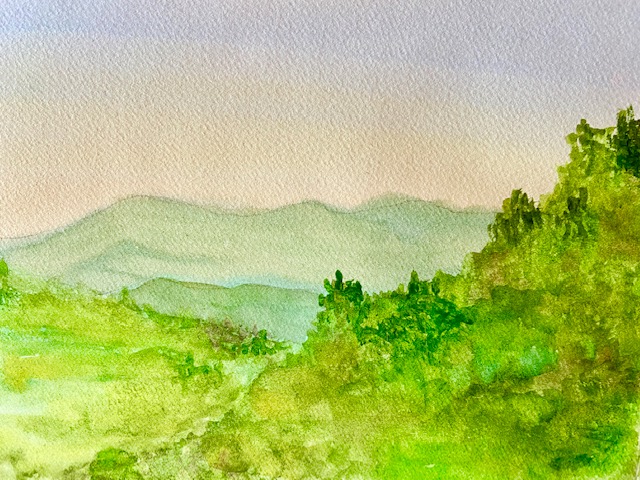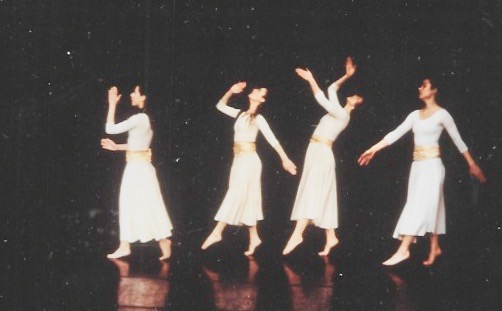In one of the many Jewish newspapers or magazines that I followed I saw a notice about a Jewish Film Festival in Pitigliano, Italy, organized by Michela Scomazzon Galdi, who lived in Rome. I thought maybe they might be interested in adding a dance event. I sent Deborah information about it, along with Galdi’s contact information, and much to my delight Deborah was able to get in touch with her and even headed into Rome to meet with her. Later Deborah would travel to Pitigliano to see the space and figure out theatre technicalities. There was much correspondence between all the parties in Italy as well as between Deborah and me figuring out details for our participation for the opening night of the festival, October 31, 1999.
Deborah also wanted us to have more than one performance and began working with some school contacts to see if she could arrange a workshop and performance in nearby Tuscania.
I knew that our budget would be extremely limited, so there was no way that the whole Avodah company could go, and part of the fun and challenge would be working with Deborah’s dancers. It would be ideal if Kezia could go too. Kezia could help teach as well as perform in the concert and an added bonus was that it would be fun to travel and tour a bit too.
Deborah remembers, “In the summer before you and Kezia came to Italy, I headed home to the US with a long stop in NYC to rehearse with you. As I was planning my trip, several of my dancers – Anna, Cinzia and Francesca wanted to tag along and visit NYC. I said sure and they came and so we had rehearsals there in Chinatown – getting them into some of the pieces for Pitigliano. Also, Silvia Manciani happened to be in New York studying at Graham for an intensive and she came to rehearse with us as well, I believe.”
At the same time I had also been in contact with an enthusiastic dancer from Israel who had attended a Monday night Dance Midrash Class I led regularly in New York City. (These were improvisation classes based on Biblical text. For more information check out Torah in Motion: Creating Dance Midrash which I co-authored with Rabbi Susan Freeman.) The dancer in Israel very much wanted me to go there and teach dance midrash and she was willing to arrange it. She followed through with an email as we were beginning to organize plans for Italy and I thought that the timing would be a perfect fit. I could fly to Italy, have one or two rehearsals with the dancers and then fly to Israel to teach. Kezia could meet me on the return to Italy and we could finish rehearsing, perform in Tuscania and at the Festival, and have a little time for sightseeing before returning to New York.
Deborah did a super job of arranging things and I remember so clearly a rehearsal before I flew to Israel. At that time Deborah had stopped running her own studio. After spending two years trying to do so, and building a small ensemble that traveled to do school performances and festivals, she had realized that the economics were just not in her favor. In fact, after teaching for two years in a studio that her Uncle Enrico had built for his ballroom-champion son, she realized she hadn’t earned a penny for herself after paying rent and the two other teachers in classical and jazz to round out the curriculum. Her husband was a dedicated documentary filmmaker and so she decided that two working artists in the family was one too many and therefore she would teach English. So when I got to Italy, Deborah was teaching English full time for the Italian Military.
I remember well the first rehearsal that I had with the dancers in the lovely studio that her Uncle Enrico had built. I was totally taken aback when someone’s cell phone rang and the person stopped dancing in the middle of the piece to answer the call. I looked at Deborah aghast and she explained that this was the custom in Italy and to just be patient. That never happened in NYC, as cell phones are turned off and only in breaks do people use a phone unless of course someone has an emergency and needs to keep it on! I soon adjusted to this more informal rehearsal style although it did leave a very clear memory in my mind. In terms of the dancing I could see the excellent progress Deborah had made with the dancers and that they would be ready for the upcoming performance.

After just a few days I returned to Rome for my short flight to Israel. Once inside the airport, I couldn’t find El Al listed anywhere. I wandered around the airport a bit and finally asked a policeman where to check in for El Al. He pointed down the hall to the farthest part of the airport. I continued walking down to an unmarked area where I soon realized there was a temporary place to check in.
I was interviewed for quite a while before being able to proceed to the next waiting area. When I got inside I was taken aback to realize that a balcony surrounded the room, and stationed at quite regular intervals were army members with machine guns. When I had traveled to Israel from the US, while security was tight it was nothing like this.
I knew that there had been an incident in the past that had warranted a high level of security, and a bit of Googling brought up the event which happened on October 11, 1982. The following description is from Wikipedia:
The attack took place at the Great Synagogue of Rome in the historic district of Rome on Saturday morning, at 11:55 AM. As the families of the local Jewish community began leaving with their children from the back entrance to the synagogue, five elegantly dressed armed Palestinian attackers walked calmly up to the back entrance of the synagogue and threw at least three hand grenades at the crowd, and afterwards sprayed the crowd with sub-machine gun fire. Eyewitnesses at the scene stated that the hand grenades bounced off the steps and exploded in the street.
A 2-year-old toddler, Stefano Gai Tache was killed in the attack after being hit by shrapnel. In addition, 37 civilians were injured, among them Stefano’s brother, 4-year-old Gadiel Tache, who was shot in the head and chest.

I found it meaningful to continue reading and learned that the event was remembered as recently as 2015.
On 3 February 2015, during the message to the Italian Parliament following his taking the oath as President of the Republic, Sergio Mattarella remembered the attack with these words: “(Italy) has paid several times, in a not too distant past, the price of hate and intolerance. I want to remember only one name: Stefano Tache who was killed in the cowardly terrorist attack on the synagogue in Rome in October 1982, He was only two years old. He was our baby, an Italian baby.”
Once through security and check-in, we were bused in groups to the far end of the airport where we boarded the plane. It was an easy, uneventful flight to Tel Aviv and I looked forward to my teaching adventure in Israel, which will be the subject of the next blog.
[print_link]



























